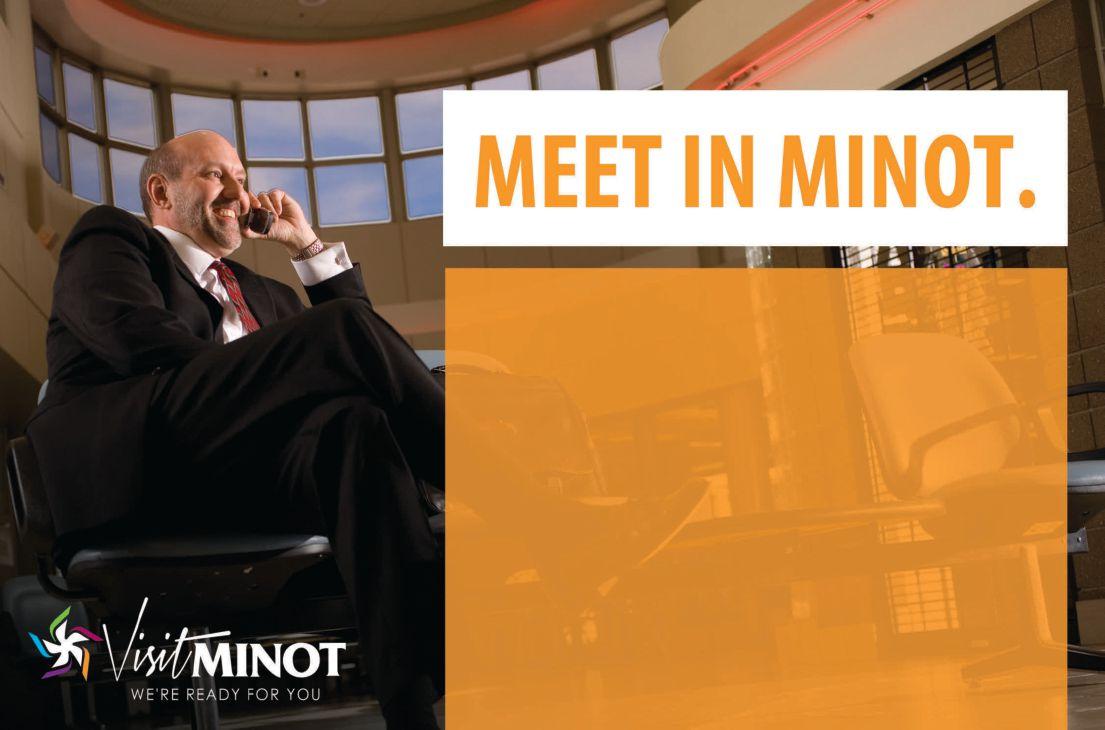
6 minute read
City of change
M inot, N.D., continues to expand, adapt to new size, demands
BY KRIS BEVILL
Not so many years ago, Stephanie Hoffart was concerned her children would one day have to leave their hometown of Minot, N D , to find careers. Today, the city’s ever-increasing population, thriving business climate and near-zero unemployment numbers are clear signs that a shortage of career opportunities is no longer a concern for Minot
“That has definitely changed,” Hoffart says. “We have over 5,000 (available) jobs that we know of in the Minot area we need people ”
North Dakota’s fourth largest city has been gaining people rapidly in recent years, although apparently not enough to sate the area ’ s appetite for workers The U S Census Bureau reported the city had a population of about 41,000 people in 2010 Best-guess estimates now place the Magic City’s population at around 55,000, with some predicting it could easily swell to 80,000 within the next five years
Airport Improvements
A 100,000-square-foot terminal under construction at Minot International Airport will dramatically increase the space available for planes and travelers. The project is expected to be complete by early 2016.
Rapid and sustained growth doesn’t come without its challenges, of course, and the Minot Area Development Corp has made it a mission to stress quality of life enhancements to retain its new residents Availability of air travel ranks among those comforts, and work has been ongoing to expand the Minot International Airport to better accommodate a growing number of passengers
Construction has begun on a $43 7 million project to build a new, much larger airport terminal. The new terminal, which is being financed mostly through state and local funds, will increase the number of gates from two to six and will be nearly 100,000 square feet larger than the current terminal rivaling Fargo’s Hector International Airport in size, according to airport director Andrew Solsvig. The new terminal is anticipated to open in early 2016, but Solsvig says it could be ready sooner “The goal is to open before the holidays, but if we can’t get everything completed then we’ll open in January 2016,” he says.
After experiencing a dramatic spike in passenger numbers in 2012 and 2013, passenger traffic through the airport this year has been flat and down slightly some months compared to last year. In September, 35,000 passengers traveled through the airport, compared to 35,889 last September In September 2011, about 27,000 passengers used the airport.
Solsv ig attributes the leveling off of passenger traffic to expanded jet ser v ice offerings at the Williston, N.D., airpor t, which he calls “the Williston factor.”
“ They’re competitive and their location w ith the rest of the Bakken oil fields puts them in a prime position, whereas Minot is on the eastern front,” he says “However we have excellent access, too, and more markets for both the business and leisure traveler ”
Despite increased offerings at other Bakken hub airports, Solsvig anticipates double-digit growth at Minot’s new terminal due in part to amenities such as ample available parking thanks to a new 800-space parking lot A hiccup in carrier availability was experienced this fall when Frontier Airlines pulled its service from Minot, but Solsvig says the airline indicated it may return in the spring In the meantime, the airport is working with other providers to offer additional flights. He stressed that Frontier’s decision to pull out of Minot appeared to be part of a restructuring decision to focus on East Coast markets rather than lack of demand as the airline suggested. “When you ’ re filling a plane 92 percent full, that’s pretty good,” he says “That’s higher than industry standard ”
Disruptive Home Building



A lack of housing, specifically affordable housing, has plagued Minot throughout its recent period of rapid growth and one farmerturned-developer has set out to be the change that he says Minot’s real estate market needs.
Nathan Smith entered into real estate in 2011 when his farmland was used as the Federal Emergency Management Agency’s temporary housing site after the Souris River flooded the city and left hundreds homeless As it became clear that a lack of affordable housing meant many of the people utilizing FEMA trailers wouldn’t be able to transition into permanent homes, Smith took an interest in developing that land further with a primary goal of cre- ating a community that people could afford to live in and would be proud to be a part of.

“There’s out-of-state developers that are coming in and aren’t delivering what our community needs,” he says “They’re building only to the highest, high-end market $350,000-$500,000 homes I had the opportunity to sell the land but I really wasn’t comfortable with the buyers, and that’s how I started in the developing game ”
Smith is turning 550 acres of land, including land previously used for FEMA housing, into a master-planned community known as 55th
Crossing Designed by Minot-based engineering and architecture firm Ackerman-Estvold, the plan calls for 400 single-family homes, 670 duplexes and a 350-pad mobile home park as well as ample green space, a school and various commercial properties. Smith expects the community to house approximately 2,000 residents when fully complete, which he says could take up to seven years
“We’re truly trying to develop an area of Minot that is a really nice place to live and is based on price points people can afford,” he says “I want an area that I’m involved with [to be] something that I’m not going to be embarrassed about in the future.”
Smith created a development firm known as Heartland Developers LLC and has begun building duplex units, which will range in price from $160,000 to $200,000 Infrastructure has also been installed to prepare lots for sale to home builders at price points that will allow them to sell single-family homes for $250,000 or less, which Smith hopes will disrupt Minot’s currently overinflated real estate market

“I’m not just trying to come in a little bit less than my competitors. We’re trying to come in substantially less and truly change the market,” he says “I don’t feel the city can grow unless somebody tries to solve this problem the affordability and that’s what we ’ re trying to do ”
Major Employers Keep Growing

Minot’s largest employer, Trinity Hospital, would no doubt be among the businesses that could benefit from more affordable housing as it continues to grow and recruit new workers to the community The organization, which serves a number of communities in central North Dakota, has increased its number of doctors from 110 to 180 in the past three years and currently employs about 2,800 people, most of whom work in Minot
“We’re still tr ying to recruit more, ” says Randy Schwan, Trinity Hospital vice president “That’s our biggest challenge is recruitment, not only of physicians but also other care providers.”
Trinity Hospital has been leasing apartments to provide transitional housing for new employees, but Schwan says the organization has recently been able to reduce the number of apartments it holds and is weaning itself off property management. Still, to combat housing and worker shortages, Schwan says the organization must continue to come up with creative strategies to recruit and retain employees That challenge is likely to continue as the organization grows A new, larger, hospital is planned and land has been purchased for the project But Schwan says he expects it could be three years before construction begins.
Not Just Oil
While Minot’s current growth in population and new business is owed primarily to its position on the eastern edge of North Dakota’s oil region, leaders including Hoffart, who recently moved into the role of president and


CEO at Minot Area Development Corp., want to ensure that its future will not be dependent on the energy industry alone Energy and agriculture are the community’s two primary industries, and Hoffart says the MADC will continuing supporting those industries as well diversifying into other areas. Manufacturing is one target area, according to Hoffart, mainly because the Bakken’s energy resources can be used to produce a large number of products “Minot would be a good place for a plastics plant or an ethane plant,” she says
In mid-October, Hoffart says a modular home manufacturer had agreed to set up shop in the MADC’s 800-acre agriculture park near the Port of North Dakota, but she could not release the name of the company. Other tenants at the ag park include United Pulse Trading, which is planning to expand its facility, and Midwest Milling.
The modular home maker was attracted to the park because of its close proximity to rail and Hoffart expects other manufacturers and value-added ag companies will show similar interest as space at the park becomes available
“We haven’t been hitting it real hard yet,” she says. “It’s been a couple-year process, but we think that once people see the rail moving and businesses in there it will entice other ones quickly.”
The MADC is also working to expand its Great Plains Energy Park to accommodate more energy companies. Six tenants fully occupy Great Plains Energy Park 1, so a second park is being established east of that location on 250 acres Hoffart says the Great Plains Energy Park 2 will be geared toward oil companies and suppor t companies that don’t require immediate rail access.
“I’m happy to know that we ’ re going to continue to diversify, we ’ re going to continue to have a good quality of life for people and I think [growth] can only be good things for Minot,” Hoffart says “I’m happy to know that there are good jobs out there and there are good people here, and we want to keep those people.” PB
Kris Bevill Editor, Prairie Business 701-306-8561, kbevill@prairiebizmag com











